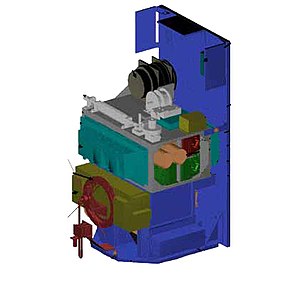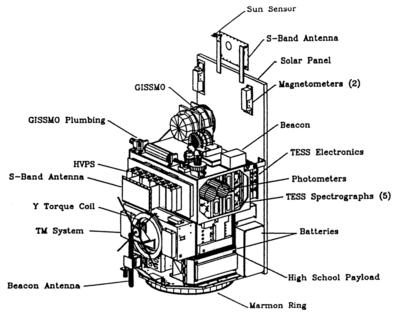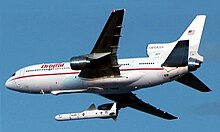TERRIERS
| TERRIERS | |
|---|---|

|
|
| Type: | Research satellite |
| Country: |
|
| Operator: |
|
| COSPAR-ID : | 1999-026A |
| Mission dates | |
| Dimensions: | 132 kg |
| Begin: | May 18, 1999, 05:09 UTC |
| Starting place: | Vandenberg Air Force Base |
| Launcher: | Pegasus-XL HAPS F27 |
| Status: | In orbit, inactive |
| Orbit data | |
| Rotation time : | 95.69 min |
| Orbit inclination : | 97.8 ° |
| Apogee height : | 550 km |
| Perigee height : | 560 km |
TERRIERS ( Tomographic Experiment using Radiative Recombinative Ionospheric EUV and Radio Sources ), and Explorer 76 , was a small research satellite of NASA to explore the ionosphere and the thermosphere , but the mission failed shortly after launch.
The main objective of the TERRIERS mission was the demonstration of techniques for measuring the electron density of the ionosphere in both two and three dimensions as well as the creation of photoemission profiles of the thermosphere by measuring the emissions of extreme ultraviolet radiation (EUV) and the application of tomographic methods. The investigation of various ionospheric and thermospheric phenomena was planned as a secondary goal. Furthermore, a technique for long-term measurements of solar EUV radiation should be tested.
background
TERRIERS was on a mission as part of NASA's Explorer program . Within the program, TERRIERS was selected as the second of three missions of the new Student Explorer Demonstration Initiative (STEDI). This initiative made it possible to realize small research satellites under the leadership of universities. A team from Boston University was in charge of the TERRIERS mission .
construction
TERRIERS consisted of a satellite structure built by AeroAstro on the basis of the HETE satellite. The satellite was spin stabilized , with the axis of rotation aimed at the sun. On the side facing the sun there were solar cells for the power supply, which was buffered by a battery for the times in the earth's shadow. Most of the instruments were arranged to the side, perpendicular to the axis of rotation, so that they scanned the surrounding space during the rotation . Another instrument was aimed at the sun. The satellite did not have its own propulsion system.
Instruments
- Five TESS (Tomographic Extreme ultraviolet Slit Spectrographs) were the main instruments of the mission. Four of these instruments were configured for observing the night side of the earth, another for the day side. The TESS instruments were one-part imaging spectrographs with high spatial resolution and high resolution for wavelengths.
- Two photometers should measure the visible light generated by chemical reactions in the high atmosphere . Structures of the electron density in this region can be inferred from these emissions.
- GISSMO (Gas Ionization Solar Spectral Monitor) was an EUV spectrometer for examining solar EUV radiation that works without optics . It should monitor solar EUV emissions in the wavelength range from 7 to 40 nm .
- Radio Beacon was a propagation beacon whose emissions were to be received by various ground stations in order to measure the states of the ionosphere.
Mission history
On May 18, 1999, an airplane-launched Pegasus XL HAPS rocket from Vandenberg Air Force Base successfully put TERRIERS into polar Earth orbit together with the experimental communications satellite MUBLCOM .
The radio contact with TERRIERS could be established immediately after it was set down, but after the second flight over the ground station it turned out that the satellite could not align itself with the sun, so that the solar cells did not supply any electricity and the satellite was only available for a short time Available energy of the battery was supplied. Reorientation commands were sent on the third pass, but TERRIERS did not respond. Later attempts at contact also failed, although there was initially hope that the satellite could reactivate itself as soon as the solar cells of the tumbling satellite accidentally received solar radiation. The mission had failed.
The inactive satellite is still in orbit as space debris. (As of December 2012)
Web links
- Boston University TERRIERS website
- TERRIERS in the NSSDCA Master Catalog (English)
- NASA: TERRIERS
- TERRIERS (STEDI 2) on Gunter's Space Page
Individual evidence
- ↑ a b c d TERRIERS in the NSSDCA Master Catalog (English)
- ↑ NASA: Student Explorer Demonstration Initiative ( Memento from April 19, 2003 in the Internet Archive ) (archive version)
- ^ Boston University: TESS
- ^ Boston University: Photometers
- ↑ Boston University: Gissmo
- ^ Boston University: Radio Beacon
- ^ Student-built TERRIERS satellite experiencing difficulties . NASA press release dated May 20, 1999
- ↑ TERRIERS satellite out of power; recovery team to be formed . NASA press release dated May 19, 1999
- ^ Real Time Satellite Tracking: TERRIERS


